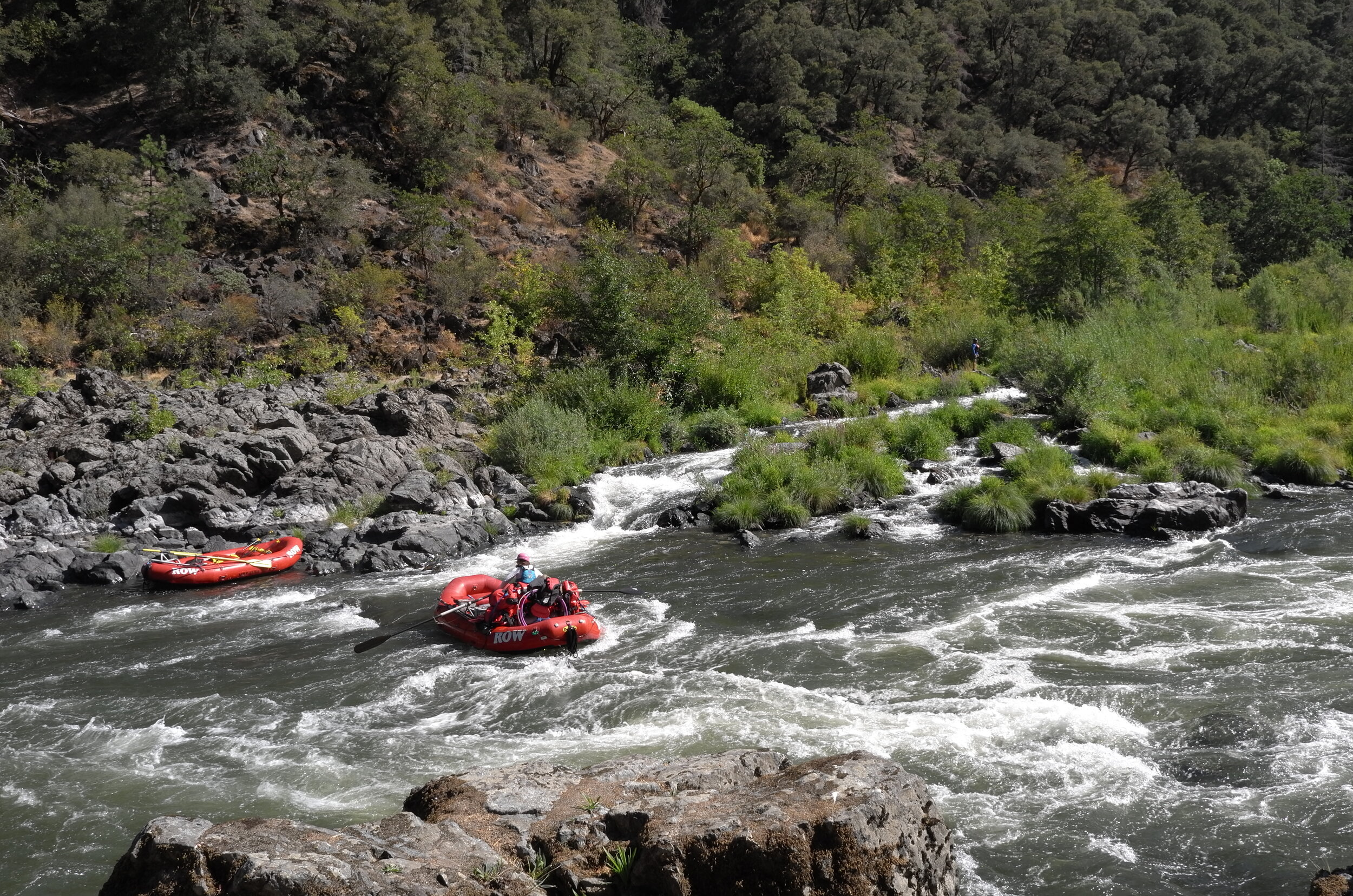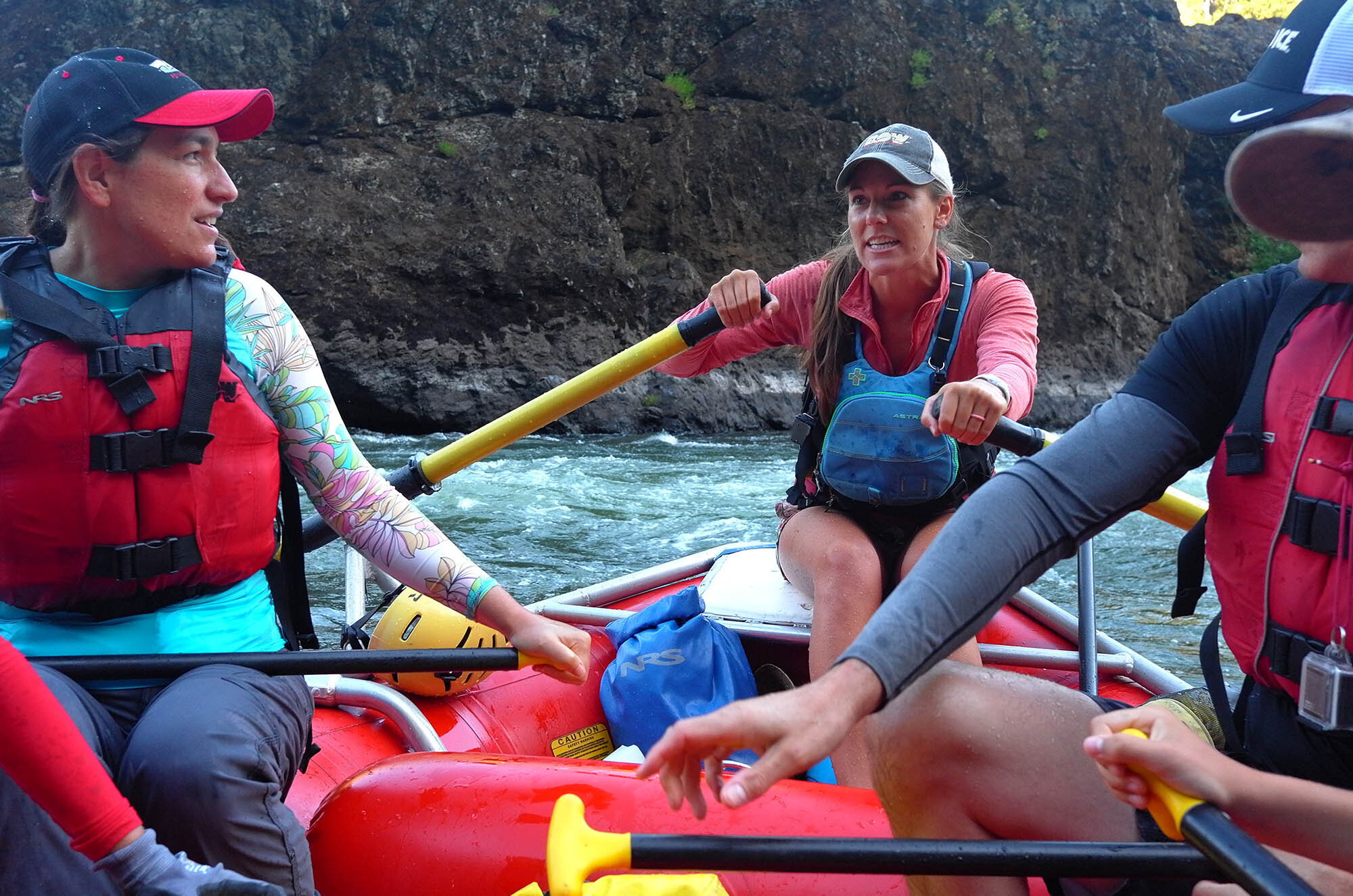What to Wear for White Water Rafting - Packing List
Whitewater rafting is an exciting sport that nearly anyone can do thanks to the many guided tours available. You don’t need any experience to go rafting as long as you go with an experienced guide, but you do need to wear appropriate clothing. Wondering what to wear for white water rafting? In this post, we’ll tell you exactly what we wore and packed for a 2-night rafting trip on the Rogue River in southern Oregon. There’s also a free PDF packing list available for download.
Whitewater Rafting Conditions
Before we talk about specific clothing, let’s talk about the environment and weather that you can expect on a rafting trip. Most commercially organized whitewater rafting trips take place in the summer. Even though the weather outside can warm up substantially, there’s a good chance that the water you’ll be rafting on will be ice cold. This is especially true in the Pacific Northwest and Colorado, but you should definitely check on the specific weather conditions of where you will be rafting.
Either way, expect to be in a mixture of full sun and shade, and also to get soaking wet. Part of the fun of whitewater rafting is getting splashed, so dive in and have fun.
ClotHES FOR WHITE WATER RAFTING
Outdoor clothing is best for white water rafting. Athletic clothing has evolved to the point that almost every sports brand makes a version of moisture-wicking fabric. This is the stuff to opt for over cotton. Not only does it repel water, but it also doesn’t wrinkle easily or take up much room, making it easier to layer or stuff in a dry bag.
While shopping for our whitewater rafting trip in Oregon, we discovered Patagonia’s Capilene Cool product line at REI. Super lightweight and soft, Capilene Cool is an amazing fabric that wicks moisture, dries fast, and manages to keep your body at a balanced temperature whether you’re in hot or cold weather. These shirts were amazing for rafting. We loved them so much that we’ve taken these shirts to the tropics, desert, and snowcapped mountains, and it is the best all-around fabric we’ve found. Seriously, try Capilene Cool and tell me it’s not the most comfortable outdoor shirt you’ve ever worn!
Swimsuits and Underwear
When whitewater rafting, you’ll likely be presented with many opportunities to get wet — either splashed by the rapids or jumping off the raft to float down the river. With that in mind, you’re better off wearing a swimsuit as your base layer rather than underwear. Ladies, consider making it a 2-piece swimsuit, just because it is much easier to use the bathroom that way. Speaking of, don’t be surprised if there are no toilets on your route and you simply have to duck into a bush or squat in the river to do your business (this was the case on our Rogue River trip!).
You’ll still want to bring underwear with you just to have a dry, clean pair to change into at the end of the day. We swear by Exofficio’s Give-N-Go Briefs for men and women. They’re lightweight, comfortable, and quick-drying in case they do get wet or you need to clean them in a sink.
Bottoms
Board shorts that are made of quick-drying material are a great option for whitewater rafting in warm conditions. However, it’s also a good idea to bring long pants to layer in the cold, or protect your legs from insects or getting chafed by the raft. For men, water resistant pants are a great option. For women, especially those of shorter stature, consider these tights that also offer UPF 50 sun protection.
Jackets
The number one jacket you’ll have with you on your trip is a life jacket. If on a guided tour, a life jacket should be included in the trip. Keep this on the entire time that you are on the water. Rivers can swell and change unpredictably, and even the best swimmers can get overwhelmed by the currents.
Depending on the weather, you may or may not need a long-sleeved jacket. It never hurts to pack one just in case. Martin and I love the Patagonia Houdini Jacket. It’s a thin jacket that repels water and keeps you warm while also folding down into a pocket-sized form. This is one of those jackets that’s great to always have on hand — it’s effective when you need it, and not a burden if you don’t.
It’s also a good idea to bring a fleece, sweatshirt, or mid-layer jacket for an extra layer of warmth, or to protect your arms from mosquitoes. Even if you don’t need it while on the raft, jackets like this are great for lounging and warming up after a long day on the river.
Shoes
Whitewater rafting calls for very specific shoes to make sure that you have a safe and enjoyable time on the water. You’ll want close-toed water shoes that secure to your feet very well. The best sandal brand is Keen, although you can also look a diving shoes as another option. The only downside to these shoes is that they take awhile to dry off.
For that reason, you’ll want to have a comfortable pair of close-toed shoes in your dry bag to wear when on land. Tennis shoes or hiking boots will do just fine. We like Altra Running shoes because they conform to your feet nicely while giving you a wide toe box for your feet to fully relax when walking. These are great walking and hiking shoes for both men and women. Don’t forget a pair of socks to treat your feet at night. Smartwool socks are our faves because they are comfortable and don’t get weighed down by sweat or moisture.
Outdoor Accessories
Polarized Sunglasses
While on the river all day, it’s important to wear or have readily accessible several forms of sun protection. The first are sunglasses. If you can, get a pair with polarized lenses — this amplifies the color of your surroundings and can have a real effect in how you perceive the things around you. It’s especially helpful for finding good compositions while snapping vacation travel photos. The other benefit of polarized sunglass lenses is that they reduce the intensity of the sun’s reflections on the water, which helps prevent eyestrain. There’s a brand called Peppers that makes lightweight, plastic sunglasses with fantastic polarized lenses. The sunglasses sit at a $40-50 price range, which is a lot cheaper than some higher-end brands. When on a a rafting trip, there’s a good chance you can lose or damage your sunglasses, so it’s not best to roll with your most expensive pair. Whatever brand you choose, don’t forget a floatable strap for your sunglasses to make them stick like glue to your face, even on the bumpiest of rapids.
Sunscreen and/or Sun Sleeves
Before setting out each day, lather up in sunscreen, and be sure to reapply it throughout the day. I prefer sunscreen in aerosol cans for easy hands-free application (I dislike greasy fingers). Roll-on applicator sunscreen is also good for applying sunscreen to your face in a pinch without greasing up your hands. An alternative to sunscreen is to wear clothing with built-in sun protection, or use sun sleeves. If you haven’t heard of sun sleeves, they’re moisture-wicking, ventilated sleeves with built-in UPF 50+. I first used sun sleeves in Belize and they were great at preventing sunburn while keeping my arms well-ventilated, even in the 90-degree weather of the tropics in direct sunlight. These sun sleeves came in extra handy on my rafting trip because they’re so easy to pull on and take off as you need them.
Hat or Buff Headband
Don’t let a fear of hat-hair prevent you from bring a hat or two on this trip. Hats are important for shielding the top of your head and face from the sun’s rays (yes, your scalp can get sunburned). A baseball cap is lightweight and conforms nicely to your head. Make sure it’s made of moisture-wicking material, and you’re golden. There’s also this baseball cap alternative that has a neck shield built in. You can also opt for a wide-brimmed hat like this one that also floats, to give the back of your neck protection. Just make sure your wide-brimmed hat has a chin strap to help secure it and prevent it from flying off in the wind. Finally, there’s the option of a Buff headband that can protect the top of your head and neck, but will leave your face exposed.
Bandana and Cooling Towel
To finish off the river rafting look, add two things to your neck. The first is a bandana, because COVID, and it blocks dust, allergies, and unpleasant outhouse smells. Finally, get yourself a cooling towel, especially if you’ll be heading to a hot area. These neat little towels get soaked in water, and then go around your neck. They have the interesting effect of keeping you cool for a long period of time, without the water leaking on you. Highly recommended if you’re easily bothered by the heat.
Large Dry Bags
If you’re going on an overnight whitewater rafting trip, be sure to bring a dry bag, if your guide doesn’t provide one. Row Adventures provided us with one large 20-liter dry bag that we filled with our overnight stuff, and a smaller 10-liter dry bag to access during the day.
Packing Cubes
We were handed these dry bags on the day of our departure and had just a few minutes to transfer our items into them. For that reason, we pre-packed our clothes and underwear into Eagle Creek Packing Cubes. These cubes are great and what we normally use in suitcases and duffel bags. They fit well into the 20-liter dry bag.
Toiletries
We also made sure our toiletries were pre-packed into our favorite lightweight Sea to Summit toiletry bags. Essential toiletries to include are a toothbrush, toothpaste, dental floss, hairbrush or comb, body lotion, shampoo, conditioner, soap, prescription medication, contact lens case and solution, glasses, and any other essential items. Don’t forget sunscreen, sunburn soothing ointment, bug spray, and After Bite.
A tip for long-haired individuals: we were lucky to stay in lodges with electric hair dryers. However, campsites and other off-the-grid lodges may not include hair dryers. A handy alternative is this hair towel wrap. It does a great job of quickly drying your hair naturally.
Comforts of Home
A few other essentials to consider packing are things that help you sleep comfortably, especially in a foreign environment. Think earplugs, sleeping eye mask, and a Cocoon sack. The latter is a new addition to my travel kit, but it has saved me many a sleepless night already. The Cocoon silk mummy liner is intended for use in a sleeping bag to prevent you from getting too sweaty and dirtying up the inside of your sleeping bag. However, this liner can also be a godsend for itchy hotel sheets or hot nights when you need a light layer. Throw this guy in your suitcase or dry bag, and you’ll thank me later.
Entertainment
When you’re not rafting, you’ll have downtime to do as you please. This is when it’s good to have some entertainment on hand. A book (or e-book or audiobook), deck of cards, small board games, and binoculars are just a few small but useful items you can throw in your dry bag for later.
In terms of electronics, your rafting route may or may not have phone service or Wi-Fi. The Rogue River had no cell signal or internet, so it made zero sense to carry cell phones with us. If you have your cell phone, use it to listen to audiobooks or music, but switch it into Airplane mode and avoid the Internet. Take this as an opportunity to reconnect with people and nature.
Day Pack Dry Bag
Even though we were loaned a 10-liter dry bag each for day use, we pre-packed everything into our own packable daypacks that had served as our personal item on our flight to the start of the rafting trip. These lightweight daypacks were slipped inside of the dry bags for protection on the water. But when we stopped for a quick hike along the river, we simply removed the daypacks and comfortably wore them on the hike. This was great for making sure all essential items were readily at hand.
Day Pack Essentials
In our daypacks, we stowed the following:
a dry set of long pants (or leggings), long-sleeved Capilene Cool shirt, pair of underwear, and socks
a thin, packable windbreaker like the Patagonia Houdini
water bottle
several Cliff bars, beef jerky, and trail mix
our dry land shoes
a microfiber towel
a baseball hat
lip balm
tube of sunscreen
sun sleeves
hand sanitizer
toilet paper
First Aid kit
headlamp or small flashlight
Waterproof Camera
How does one go about taking photos and videos of a whitewater rafting trip? It’s a tricky question and it all depends on how much risk you’re willing to take on. When you go whitewater rafting, you have to prepare for the worst-case scenario: your raft flips over and you plus your camera will be plunged into water. Depending on what kind of camera you own, it might be possible to buy a waterproof housing for it. Housing are typically not cheap and they are built to conform to specific camera models. Alternatively, you can try these waterproof baggies, but…I personally wouldn’t trust my $3,000 mirrorless camera to this. If you’re hellbent on bringing a pro-grade camera, talk to your rafting guides beforehand and see if you can work something out. There might be space for a waterproof Pelican case holding your camera (although these are waterproof, they won’t float!).
For our trip, it was a tough choice, but we decided to leave our expensive mirrorless cameras at home. It simply wasn’t worth the risk, especially since we were just on vacation, not a paid assignment. Instead, we opted for our GoPro to record videos, and we borrowed a waterproof Leica point and shoot on Borrow Lenses. I also bought a waterproof case for my smartphone to have as another camera.
Best Waterproof Camera for Video
After reviewing the photos and videos from the trip, we declare the GoPro to be the best waterproof camera. It’s so small and lightweight, and the stabilized 4K video plus wide angle lens made it ideal for catching first-person points of view of the whole trip. The sound isn’t perfect, but it works. So if you need a vacation camera and intend to shoot a lot of video, get a GoPro (Hero 7 or more recent version). We used this mount to clip the GoPro to various parts of our life vests and just kept the camera rolling. We also used these cable tethers to secure the GoPro to the vest, just to make sure it wouldn’t get bumped off. The only other mount we wished we had was the GoPro 3-Way. The extending arm would have been helpful for capturing other perspectives, such as reaching out in front of the raft and shooting backwards.
Best Waterproof Camera for Still Photography
Spoiler alert — the waterproof Leica we tried was not great at photos or videos. It looks cool, but we don’t recommend it. Instead, get an Olympus Tough camera. This rad point and shoot cameras are nearly indestructible, and they shoot really really good still photos. It can also shoot 4K video, but stills are more its strong points. We were first sold on the Olympus Tough over the GoPro back in the day (we had a Hero 2), and it looks like Olympus Tough is still going strong. Check out some sample photos taken with the Olympus TG-2 here, but we warned that there’s a newer TG-6 camera out that will perform much better.
Camera Accessories
If you bring a camera (and you should!), don’t forget a few essentials including an extra-big memory card, a spare battery, an external battery charger, and a floating wrist strap.
What Not to Bring
There are a quite a few things that you shouldn’t bring on a rafting trip. The best way to think of it is this: if my raft flips over and I either lose it or the water destroys it, will I be upset? If the answer is yes, don’t bring it. This brings to mind things like valuables — jewelry, watches — and non-waterproof electronics. Leave the Netflix and Nintendo Switch home and just enjoy nature’s entertainment. It’s just for a short while, and the break from technology will do you good.
In Conclusion
There you have it! A list of what to wear for whitewater rafting, along with things to pack, and things to leave at home. Are we missing anything from the list? Let us know in the comments below.
If you want to get pumped for your next rafting trip or see how ours unfolded (yes, we vlogged it), check out our Rogue River Rafting blog.
River Rafting Packing List - Free Download
Get your free checklist here.






